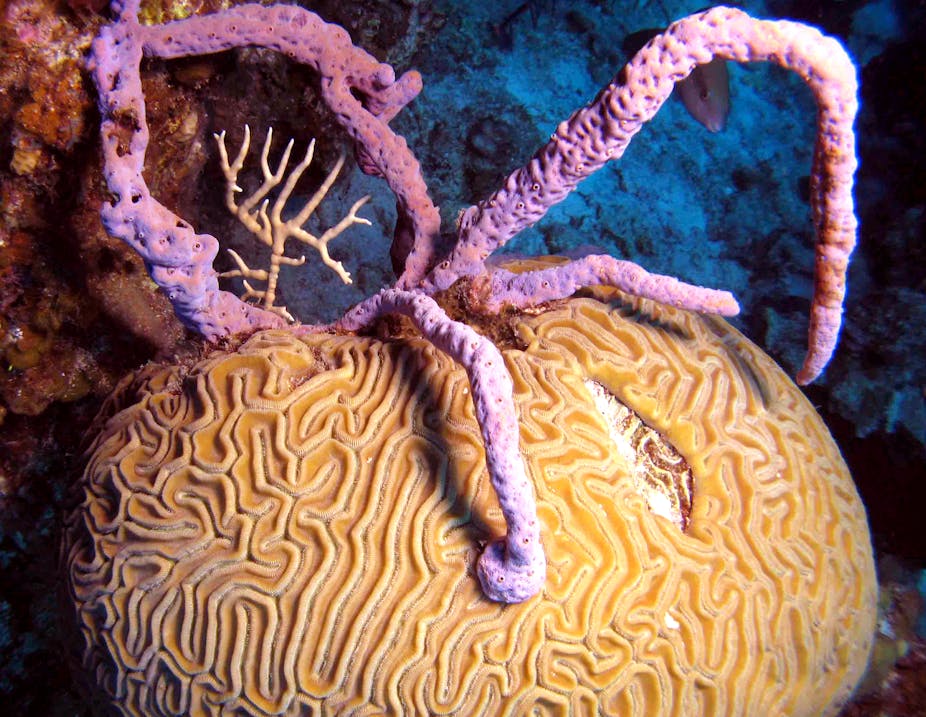SpongeBob SquarePants, perhaps the world’s most famous sponge, is the star of his own cartoon show set in the ocean-floor city of “Bikini Bottom”. In the real world, however, sponges are often perceived as playing only a supporting role to the real reef stars: corals.
But new research, published in PeerJ, has once again highlighted sponge-power. These squishy creatures, it is feared, might take over coral reefs if not kept in check by sponge-eating fishes – and overfishing is removing their natural predators.
A team of researchers from the University of North Carolina assessed coral reefs in 12 Caribbean countries. They compared sites where fish stocks are depleted due to intensive fishing with more protected sites where fish still exist in greater numbers. Twice as many coral colonies were found in contact with sponges at the overfished sites.

This matters because sponges have been shown to have the potential to kill corals, and corals are among the key organisms in any reef. Their calcium carbonate skeletons lay the foundation of precious and immensely complex ecosystems on which about a third of all marine species depend on. So any threat should be taken very seriously. Increased exposure to often toxic sponges raises concerns that sponges might be able to out-compete corals.
Many sponges contain a complex cocktail of toxic and distasteful compounds, chemical weapons accumulated to defend themselves from being eaten or overgrown by other organisms. This makes them interesting sources for potential new drugs. But in the absence of predators, it appears this arsenal can be also used in an offensive manner against corals to prepare the ground for their own expansion.
Shy assassins

Sponges usually adopt a hidden lifestyle underneath boulders and in a reef’s cracks and crevices, at least partly to avoid predators such as parrotfish and angelfish. In fact, previous research using the same endoscopic techniques surgeons use to look inside human bodies demonstrated that the majority of sponge biomass lives not on top of a reef but within it.
Apart from these species that make use of existing hollows, the not so dull “boring sponges” even produce acids to drill themselves a home.

They aren’t too worried about where they set up their residence, as long as it consists of chalky material. Boring sponges can therefore be not only found in limestone rock but also in various types of animal and plant shells and skeletons, including those of live and dead corals. This is of critical concern since it renders the coral colonies more fragile and vulnerable to damage by strong waves.
There are exceptions to the rule of course, and a number of sponge species form erect structures on the seabed. One of these, the majestic barrel sponge, can grow to a diameter of nearly two metres and can live for up to 2,000 years.

Sponge waste breathes life into the oceans
Sponges play a vital role in the functioning of coral reef ecosystems. They can filter large quantities of water through their many pores and then squirt it through their bodies, removing tiny plankton creatures and organic compounds for food. It is this porousness which gives sponges the natural and much-appreciated ability to retain large amounts of liquid for cleaning purposes.
The waste products of the sponge diet contain nitrogen and phosphorus compounds, which are dearly needed by the bacterial and plant life of the usually nutrient-deprived reefs. Sponges have also found another way of ridding themselves of their waste: by rapidly replicating cells and shedding them in large numbers. These cells are either eaten by other organisms or decompose, again, releasing valuable nitrogen and phosphorous.
Through these mechanisms sponges can supply nutrients that might otherwise not be accessible to the reef creatures or would be lost to the oceans surrounding the reefs. This nutrient cycle has been termed “sponge loop” and helps to explain the Darwin Paradox – the puzzling observation, first noted by the man himself, that coral reefs form these amazingly productive oases in the midst of a nutrient-poor ocean desert.

You can have too much of a good thing, however. Excess nutrients introduced in coral reefs through fertilisers, sewage dumping or stirring-up of sediments have the potential to severely disturb their vulnerable ecological balance. Apart from rendering corals more susceptible to bleaching, more nutrients stimulate the production of plankton thereby increasing the availability of food for sponges.
As a consequence, corals may suffer from destabilisation of their skeletons or the reef framework due to boring sponges or potentially increased competition for space, in particular if the affected reefs are overfished.
In the Caribbean, coral cover – the proportion of reef that is live coral rather than sponge or algae – has declined dramatically from more than 50% in the 1970s to around 10% today. Overfishing and die-outs of herbivores, eutrophication and pollution, invasive species, diseases and climate change have taken a heavy toll on these once flourishing reefs.
Despite the differences in sponge-coral contacts reported in the latest study, the coral cover at these overfished and less fished sites hasn’t differed substantially. The battle between sponges and corals is only just unfolding.

It is awful to see coral in such a bad state – after all who doesn’t love the image of a pristine, colourful reef, full of amazing fish? – but sponges aren’t the real villains of this recent reef drama. As overfishing has removed many of their natural enemies it appears sponges have been handed an unfair edge over the corals. Once again, fingers point in the direction of us humans.

